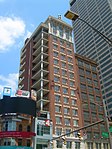William J. Lhota Building
1905 establishments in OhioAC with 0 elementsBank buildings in Columbus, OhioBuildings in downtown Columbus, OhioCentral Ohio Transit Authority ... and 5 more
Commercial buildings completed in 1905Historic district contributing properties in OhioNRHP infobox with nocatNational Register of Historic Places in Columbus, OhioOffice buildings in Columbus, Ohio

The William J. Lhota Building is a historic office building on High Street in downtown Columbus, Ohio. The building is primarily known as the headquarters of the Central Ohio Transit Authority (COTA), the city's transit system. It is owned by COTA, with some office space leased to other organizations. The building was added to the National Register of Historic Places as part of the High and Gay Streets Historic District in 2014.
Excerpt from the Wikipedia article William J. Lhota Building (License: CC BY-SA 3.0, Authors, Images).William J. Lhota Building
West Lynn Street, Columbus
Geographical coordinates (GPS) Address Nearby Places Show on map
Geographical coordinates (GPS)
| Latitude | Longitude |
|---|---|
| N 39.962988888889 ° | E -83.001319444444 ° |
Address
William J. Lhota Building
West Lynn Street
43215 Columbus
Ohio, United States
Open on Google Maps










